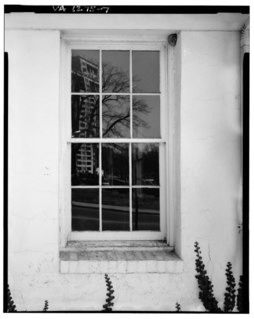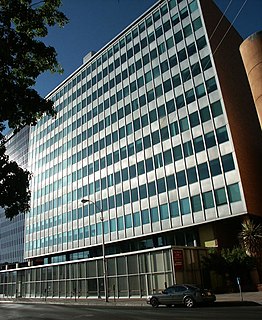
The Simms Building is historic high-rise office building in downtown Albuquerque, New Mexico. Designed by Flatow and Moore and completed in 1954, it was the city's first large-scale modernist building and is regarded as "Albuquerque’s best example of the International Style". The building was added to the New Mexico State Register of Cultural Properties in 1997 and the National Register of Historic Places in 1998, only 44 years after it was completed.

San Felipe de Neri Church is a historic Catholic church located on the north side of Old Town Plaza in Albuquerque, New Mexico. Built in 1793, it is one of the oldest surviving buildings in the city and the only building in Old Town proven to date to the Spanish colonial period. The church is listed on the New Mexico State Register of Cultural Properties and the National Register of Historic Places and has remained in continuous use for over 200 years.

Old Town is the historic original town site of Albuquerque, New Mexico, laid out by Spanish colonists in the 1700s. It is listed on the New Mexico State Register of Cultural Properties as the Old Albuquerque Historic District, and is protected by a special historic zoning designation by the city. The present-day district contains about ten blocks of historic adobe buildings surrounding Old Town Plaza. On the plaza's north side stands San Felipe de Neri Church, a Spanish colonial church constructed in 1793.
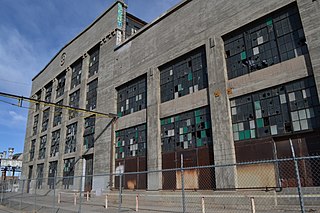
The former Santa Fe Railway Shops in Albuquerque, New Mexico, consist of eighteen surviving buildings erected between 1915 and 1925. The complex is located south of downtown in the Barelas neighborhood, bounded by Second Street, Hazeldine Avenue, Commercial Street, and Pacific Avenue. The shops were one of four major maintenance facilities constructed by the Atchison, Topeka and Santa Fe Railway, the others being located in Topeka, Kansas, Cleburne, Texas, and San Bernardino, California. The railway shops were the largest employer in the city during the railroad's heyday. Currently they have been empty for years but a variety of plans have been proposed for the historic complex.

The Laguna Pueblo is a federally recognized tribe of Native American Pueblo people in west-central New Mexico, USA. The name, Laguna, is Spanish and derives from the lake located on their reservation. Originally, this body of water was the only lake in what is now the state of New Mexico, and was formed by an ancient dam that was constructed by the Laguna people. After the Pueblo Revolt of 1680-1696, the Mission San José de la Laguna was erected by the Spanish at the old pueblo, and finished around July 4, 1699.

The Estufa is a historic structure on the University of New Mexico campus in Albuquerque, New Mexico. It was built in 1907–08 by a local social fraternity and has served since 1915 as the primary meeting location of the university's Pi Kappa Alpha chapter. The building's history is steeped in fraternity lore and supposedly no woman has ever seen its interior. It is listed in both the New Mexico State Register of Cultural Properties and the National Register of Historic Places.
Tjalke Charles Gaastra was an American architect who worked in the American southwest in the first half of the twentieth century. He won the International Exhibit of Architecture in Berlin for the Gildersleeve house in Santa Fe, New Mexico which he designed for New Mexico Supreme Court justice, David Chavez. Gaastra was a major player in the Spanish Pueblo Revival architectural style in Santa Fe, New Mexico.

The Old Armijo School, also known as the Ranchos de Atrisco School, is a historic school building in the South Valley area of Albuquerque, New Mexico. It is notable as one of the only surviving school buildings attributed to Atanasio Montoya, a noted educator who reformed and modernized the Bernalillo County school system in the early 20th century. The school was added to the New Mexico State Register of Cultural Properties and the National Register of Historic Places in 1982.

The Santa Barbara School is a historic school building in the Martineztown-Santa Barbara neighborhood of Albuquerque, New Mexico. Built in phases between 1908 and 1930, it is one of the city's oldest surviving school buildings and is notable for its association with Atanasio Montoya, a noted educator who reformed and modernized the Bernalillo County school system in the early 20th century. The school was added to the New Mexico State Register of Cultural Properties and the National Register of Historic Places in 1989.
The history of Albuquerque, New Mexico dates back up to 12,000 years, beginning with the presence of Paleo-Indian hunter-gatherers in the region. Gradually, these nomadic people adopted a more settled, agricultural lifestyle and began to build multi-story stone or adobe dwellings now known as pueblos by 750 CE. The Albuquerque area was settled the Tiwa people beginning around 1250. By the 1500s, there were around 20 Tiwa pueblos along a 60-mile (97 km) stretch of the middle Rio Grande valley. The region was visited by Spanish conquistadores beginning with the expedition of Francisco Vázquez de Coronado in 1540–41, and began to be settled by Spanish colonists after the expedition of Juan de Oñate in 1598. By 1680, 17 Spanish estancias were reported along the Camino Real in the Albuquerque area.

Scholes Hall is the historic administration building of the University of New Mexico, located on the main campus in Albuquerque. It was the first of many buildings designed for the university by Santa Fe architect John Gaw Meem, who helped to cement the Pueblo Revival style as the "official" architecture of the campus. Built in 1934–36 with Public Works Administration funding, it is regarded as one of Meem's most notable designs.
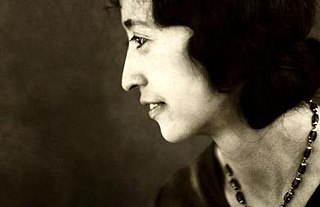
Erinea Garcia Gallegos (1903–2002) was a Hispanic American educator and postmistress. Born in Conejos, Colorado, her family had deep roots in the region, being among the first settlers of the San Luis Valley that overlaps southern Colorado and northern New Mexico. She taught in elementary schools before her marriage and afterward served as postmistress of San Luis for nearly four decades. She was posthumously inducted into the Colorado Women's Hall of Fame in 2012.

Martineztown-Santa Barbara is a neighborhood in central Albuquerque, New Mexico, immediately northeast of Downtown. Originating as a small farming village in the 1850s, it is one of the city's oldest neighborhoods and retains a distinct character, with winding streets, irregular lots, and adobe vernacular buildings reminiscent of other old Hispanic communities in northern New Mexico.

San Jose de los Duranes Chapel is a historic building in Albuquerque, New Mexico. The chapel was built around 1890 to serve the community of Los Duranes, one of several outlying plazas spread along the Rio Grande in the vicinity of the main plaza at Old Town Albuquerque. The chapel was replaced with a new, larger San Jose Church in the 1960s, and fell into disrepair. In 1982–4, community members undertook a restoration of the building, replacing damaged or missing pews, rails, and doors, plastering the walls, repairing holes, and reinstalling the original religious artwork including paintings of the Crucifixion and a santo depicting St. Joseph. It was listed on the New Mexico State Register of Cultural Properties in 1983 and the National Register of Historic Places in 1984.

The Barela–Bledsoe House is a historic house in the North Valley of Albuquerque, New Mexico. It was built around 1870 by Juan Estevan Barela (1842–1886), a prosperous farmer and merchant. At the time of his death, he owned over 100 acres (0.40 km2) of land and 13,000 sheep. The house was inherited by his widow Abundia García de Barela, who owned the property until her death. In the twentieth century, it was the residence of Robert Dietz III, whose previous home is also a listed historic property. The Barela–Bledsoe House was listed on the New Mexico State Register of Cultural Properties in 1976 and the National Register of Historic Places in 1979.
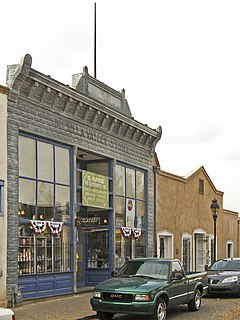
The Barela-Reynolds House is a historic adobe and brick building complex on the historic plaza in Mesilla, New Mexico, with a store at the front and a house at the rear. A zaguan leads to a rear courtyard about 30 by 30 feet in plan, enclosed by the buildings, the oldest of which were built around 1850. Two separate parts were merged into one property in 1903. North of the zaguan was a store operated during the 1850's by trader Mariano Yrissari and later by trader Mariano Barela. The front of this portion is topped by a triangular parapet, a Greek Revival style feature adopted into New Mexico's Territorial style, and the triangle is repeated in pedimented lintels of two doorways and two large windows. This part was a silversmith shop, "El Platero", in 1977, which moved to the other part by 2009. South of the zaguan is a portion occupied by an antique shop, "Las Viejas", in 1977. This part has a cast iron front and a metal, bracketed cornice, with a flagpole centered above. It was the "notions and dry goods department" of the Reynolds and Griggs Co., a firm which operated feed and grocery business in the next building to the south, not part of this property.












